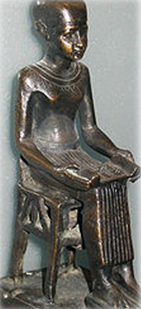The bright desert sun shines up in the distance, a mirror like appearance casts near the horizon. The land stretches on repeating the pattern of rock, sand and heat in every direction. Through this uninhabited landscape stands a monolithic monument having faced the absolute test of time, it speaks volumes on the grand legacy that were its original creators. While the latter have long gone, the former remains, like a mark etched in time itself.
 In the remote northwestern corner of the city of Memphis, Egypt, lies an ancient burial ground, Saqqara, final resting place for kings of every time and dynasty. It is here that we find the Pyramid of Djoser (zoser), the portal through which it was believed that the pharaoh Djoser would pass on to afterlife. Built during the 27th century BC by his vizier Imoteph, High Priest of the sun god Re and architect of the pyramid. Imoteph was considered a man of the highest status after only the king, and was revered as a god after his death.
In the remote northwestern corner of the city of Memphis, Egypt, lies an ancient burial ground, Saqqara, final resting place for kings of every time and dynasty. It is here that we find the Pyramid of Djoser (zoser), the portal through which it was believed that the pharaoh Djoser would pass on to afterlife. Built during the 27th century BC by his vizier Imoteph, High Priest of the sun god Re and architect of the pyramid. Imoteph was considered a man of the highest status after only the king, and was revered as a god after his death.Believed to be either the first or second king of the 3rd dynasty (2667 – 2648) of the Old Egyptian Kingdom (2686 – 2125), Djoser ruled for 19 years. Though many archeologists suggest the 19 years were ‘biennial taxation years’ therefore rendering him king for 39 years. Either way, Djoser lived long enough to see his monumental final abode be completed in his life time.
The Pyramid of Djoser set its mark in history by departing from previously designed pyramids. Also called the Step Pyramid, for it stands on 6 mastabas of decreasing size, became the first of its kind in both complex design and as the first large scale cut stone construction of its time. Standing at a height of 63 meters with a base of ‘109 x 125’ meters enveloped in white polished limestone it was the peak of human engineering of its time. The pyramid had several implications both social and economic. It was much more complex than the mud-brick ones of its predecessors therefore required much more labor and resources. This hinted towards the fact that the royal government had acquired much more wealth than its predecessors. Furthermore it set the stage for its successors to incorporate elements of the Step Pyramid in future dynasties including the legendary pyramid of Giza. Lastly, it if among the rare pyramids where the architect has been identified, in this case it was Imoteph whose name was inscribed on a seal in the room of the sarcophagus.
The Pyramid of Djoser is thought to be built in several stages being an experimental structure. The superstructure began life with a square base, that was later expanded (towards the east) into a rectangular shape of a mastaba. Initially it was developed to a four step structure, and then later into the six steps structure that stands today. These changes in original design inclined towards several revisions of the original model. It is also argued that since the base of the pyramid was initially square, the structure was never meant to be a mastaba. Furthermore, there are several proofs that lead towards the monument being an experimental structure. For one, it was constructed so that the core of the mastabas would comprise of rubble and rock, however during the construction of the steps the builders shifted to using larger rocks of higher quality (assumed to be mined from the great trench) in a fashion of accumulating the material together that leaned inwards. The whole superstructure was later clad in limestone. Although unclear, it is widely assumed that simple technology such as ramps would have been employed in raising the stones to the pyramid.
Below the magnanimous monument lies a labyrinth of tunnels and passageways totaling an astonishing 6 Km in length, finally leading up to a 7 meter wide square central shaft descending down to 28 meters. The spaces at the end led to the burial chambers of the king and family members, and storage areas mostly used to offerings and items thought would be required by the king in his afterlife. The inside walls of the chambers and passages are intricately carved with designs and hieroglyphics portraying the king involved in several types of activities. The sarcophagus room had been designed as a smaller replica of the king’s palace with blue faience (earthenware) while the walls were decorated with stone panels. This room was to serve as the living area of the royal Ka (Spirit).
Intended to serve as a gateway to an eternal afterlife, the Pyramid of Djoser was a scheme too grand even for its own time. The monolithic superstructure set not only standards for several dynasties spanning centuries to build upon, but also left future generations of beings perplexed on the true symbolism for its innovative architecture as well as questions regarding how the stone giant was constructed, were all but left unanswered, buried in the shifting sands of the once, land of the Pharaohs.
Until next time amigos! =]]
Nauman Sharif !
*This post has been approved by The Tough Cookie!*
